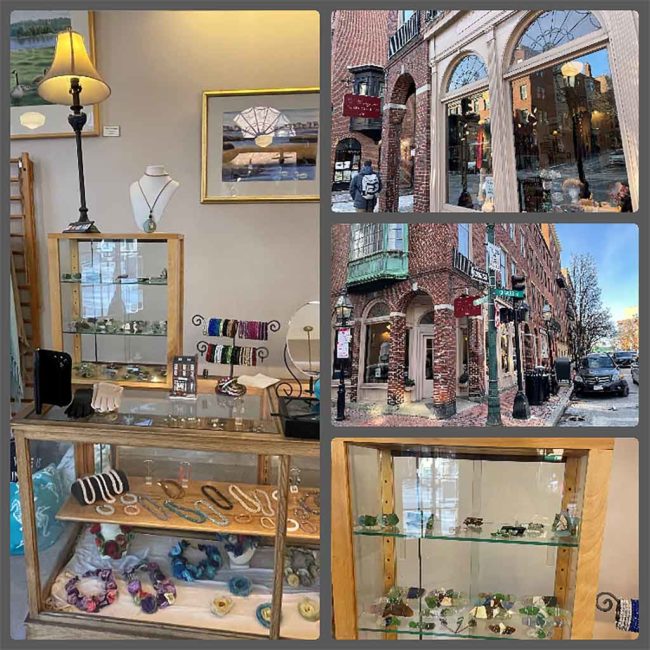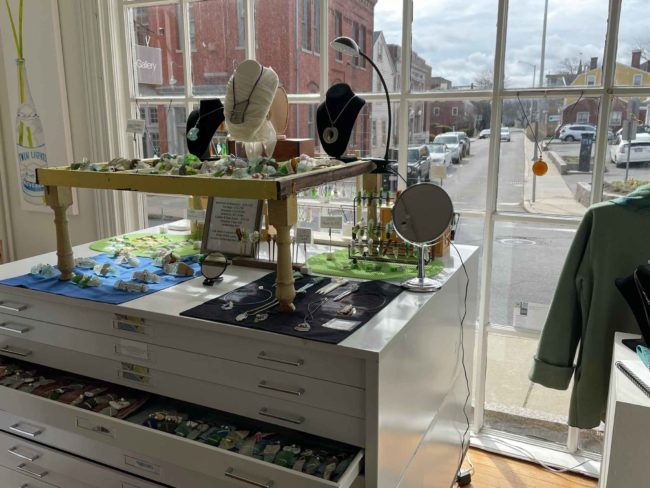Adventures in Gallery Hunting | Finding the right fit to sell your work
A few takeaways and tips from the DIY approach, by Jacqueline Ganim-DeFalco and Beth Williams.
As much as we all love to make work, it’s also important to get it out there for others to see and hopefully purchase! This is a good time of year to consider some new directions. There’s both an art and science to approaching galleries and retail outlets to sell your work. It takes a bit of work, some good business tactics, and sometimes luck to find the right places to carry your work and then to sell it over the long term. This is a two-part blog based on our combined experiences. We hope it helps others as they grow their art business. Thanks for reading!
Early Decisions
From day one when I began making sea glass accessories, I knew I wanted them out in the world and not piling up in my workspace (prior to even having a studio). I also decided early on that I would sell both directly and indirectly, but would shy away from large traditional shows because I wanted to make the work myself. Therefore, I am calling this the DIY approach for boutique sized “makers” who don’t want to spend all their weekends going from show to show. Shows are another route, but not addressed here.
I had no prior retail experience despite my BTB marketing background, so I had to develop my own approach. So, after my first batch of hair-clips were done, I marched into downtown Gloucester to a local retail shop and asked if they would accept them on a consignment basis. I learned two things immediately – first I had priced them too low and second, you just don’t know until you try.
Research is your friend
Since then, I have had a wide range of experiences and have accumulated binders full of research on galleries in high-traffic arts destinations. Doing this independently is not easy, but it’s a great way to stay in touch with your audience, test your selling skills, and also test the “market” while personally confirming that the venue is a good fit for your work (more on that later). Living here in New England and finding retail outlets in other climates also takes the sting out of the mid-winter slump in retail as we all hunker down and lock ourselves indoors!
While doing some learning on my own, I also started to meet other more experienced artists. Thanks to fellow artists like Beth Williams, I did get some good advice to add to my arsenal. Together we have compiled some tips and funny stories from the “road” to share with fellow artists.
Getting the actual lay of the land in an area is the ideal situation. Planning 1-2 day trips within a 4 hour drive can be a good way to get started. Walking the “beat” really helps you find out where your work might fit in, price points, how shops display your work, traffic flow, etc. A good second choice is reaching out to your personal network to have them do this for you in areas that may be further away. Give your friends a list of things to look for and questions to ask and make them part of your reconnaissance team. I often anoint them formally and call them my top sales team!
After you get recommendations, be sure to follow up with your own online research or eventually visit the location. You want your work to “fit in but not blend in”; styles, price points and overall aesthetic should complement other work in the venue. This is a great time to reach out to other makers you might know who also sell in those venues; someone who already has history with a particular gallery can give you the inside scoop on their experience.
Knocking on Doors
Probably the most important factor in getting into a shop is understanding their buying season (to look at your work) or selling season – when customers are most active. Peak selling season is definitely the worst time to contact a shop.
Next, it’s critical to have your marketing information together (photos, website, pricing, bio, artist statement, etc.) Also, prepare for the possibility that you may be expected to have one “exclusive” shop in smaller geographies.
Email ahead and ask how the buyer prefers to be contacted for an appointment, i.e. email or phone; very seldom does a gallery owner have time at the spur of the moment. It’s perfectly fine to have a couple of pieces tucked into a purse or in your car, just in case – (and if you’re a jewelry designer ALWAYS wear some of your work), but don’t expect them to drop everything to look over your work. Do have some of your promotional materials put together so you can leave something for them to look over at their leisure if/when they show interest. Let’s face it, you may have to kiss a lot of frogs and hear some really absurd rejections, but it’s all part of the adventure.
My funniest moments have been people telling me that my work would not sell in their shop. In many cases, it was one of their best customers that recommended me to call on them and those people would like to be able to buy my work there. Though it has always made me chuckle, the truth is that many shop owners enjoy discovering artists on their own and firmly believe that if they choose and like something, their customers will. Given all the challenges to owning a retail shop, deciding on what they want in the shop is one of the few fun things they get to do. [Jackie Ganim-DeFalco]
Use your interaction wisely
If you do get a chance to engage in conversation on the phone or in a store, be sure you ask the right questions. Here are some to get you started that will determine how far you can go in the conversation.
- How do they do their selection & buying, do they buy themselves or are they part of a buying network?
- Do they have similar work in your genre? If so, what are the typical price points?
- Do they work on consignment, wholesale or a blend?
Tip: Research consignment contracts ahead of time; they may give a little added protection if you decide to consign your work. Most/many galleries and museum shops will have their own versions; you are actually loaning your work to someone, without collateral, for a period of time and trusting to their good will to care for, protect and market your work…and pay you for it once it sells. Find out who is liable if a piece is broken or goes missing; this can happen and you will need to decide up front if you are willing to accept how they deal with those issues. [Beth Williams]
Learn to “trust your gut” and be prepared! These can turn into long term relationships/friendships that are very satisfying and lucrative, but the opposite can happen as well.
In Part II, we will discuss how to interact with venues once you are in, how to deal with the rejection you may get from some of the places you approach, and how to grow the relationships over time.




